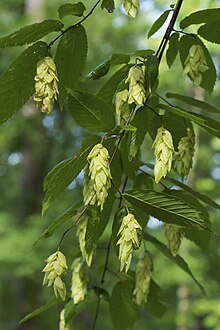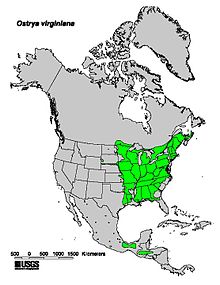| American hophornbeam | |
|---|---|

| |
| A hophornbeam branch with the characteristic hop-resembling fruits[1] in early summer | |
| Scientific classification | |
| Kingdom: | Plantae |
| Clade: | Tracheophytes |
| Clade: | Angiosperms |
| Clade: | Eudicots |
| Clade: | Rosids |
| Order: | Fagales |
| Family: | Betulaceae |
| Genus: | Ostrya |
| Species: | O. virginiana
|
| Binomial name | |
| Ostrya virginiana | |

| |
| Generalized native range | |
| Synonyms[3] | |
| |
Ostrya virginiana, the American hophornbeam, is a species of Ostrya native to eastern North America, from Nova Scotia west to southern Manitoba and eastern Wyoming, southeast to northern Florida and southwest to eastern Texas.[4] Populations from Mexico and Central America are also regarded as the same species, although some authors prefer to separate them as a distinct species, Ostrya guatemalensis.[3] Other names include eastern hophornbeam, hardhack (in New England), ironwood, and leverwood.[5][6]
- ^ Cite error: The named reference
Easternwas invoked but never defined (see the help page). - ^ Stritch, L.; Shaw, K.; Roy , S.; Wilson, B. (2014). "Ostrya virginiana". IUCN Red List of Threatened Species. 2014: e.T194540A2346581. doi:10.2305/IUCN.UK.2014-3.RLTS.T194540A2346581.en. Retrieved 19 November 2021.
- ^ a b "Ostrya virginiana". World Checklist of Selected Plant Families (WCSP). Royal Botanic Gardens, Kew.
- ^ "Ostrya virginiana". County-level distribution map from the North American Plant Atlas (NAPA). Biota of North America Program (BONAP). 2014.
- ^ Furlow, John J. (1997). "Ostrya virginiana". In Flora of North America Editorial Committee (ed.). Flora of North America North of Mexico (FNA). Vol. 3. New York and Oxford: Oxford University Press – via eFloras.org, Missouri Botanical Garden, St. Louis, MO & Harvard University Herbaria, Cambridge, MA.
- ^ Nelson Sutherland, C.H. (2008). Catálogo de las plantes vasculares de Honduras. Espermatofitas: 1-1576. SERNA/Guaymuras, Tegucigalpa, Honduras.
